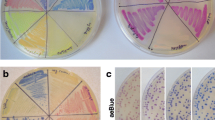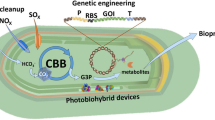Summary
The binding and uptake of nick-translated 32P-labeled pBR322 by Anacystis nidulans 6301 have been characterized. Both processes were considerably enhanced in permeaplasts compared to cells. The breakdown of labeled DNA was not correlated with binding or uptake by permeaplasts or cells. Uptake of DNA by permeaplasts was unaffected by: Mg2+ or Ca2+, light, or inhibitors of photophosphorylation such as valinomycin or gramicidin D in the presence or absence of NH4Cl. ATP at 2.5–10 mM inhibited both binding and uptake of labeled DNA by permeaplasts of A. nidulans whereas the ATP analog adenyl-5-yl imido-diphosphate was non-inhibitory in the same concentration range. In contrast to transformation of A. nidulans 6301 cells to ampicillin-resistance by pBR322, transformation to kanamycin-resistance by the plasmid pHUB4 was considerably enhanced in the dark. The transformation efficiency for permeaplasts by the plasmid pCH1 was 59% and 8% in the dark and light, respectively, whereas transformation of permeaplasts by pBR322 at an efficiency of 16% was absolutely light-dependent.
Similar content being viewed by others
References
Allen MM (1968) Simple conditions for gowth of unicellular bluegreen algae on Plates. J Phycol 4:1–4
Bernard H, Remaut E, Hershfield MV, Das HK, Helinski DR (1979) Construction of plasmid cloning vehicles that promote gene expression from the bacteriophage Lambda PL promoter. Gene 5:59–76
Brzobohaty B, Kovac L (1985) Interaction of plasmid DNA with yeast protoplasts and a mechanism of genetic transformation. FEBS Lett 183:211–214
Buitenwerf J, Venema G (1977) Transformation in Bacillus subtilis: Fate of transforming DNA in transformation deficient mutants. Mol Gen Genet 151:201–213
Charles DJ (1977) Uptake of bacterial DNA by Anacystis nidulans. Genetical and Biochemical study. (Abstract) J Protozol 24:62A
Chuvat F, Astier C, Vedel F, Joset-Espardellier F (1983) Transformation in the cyanobacterium Synechococcus R2: Improvement of efficiency; role of the pUH24 plasmid. Mol Gen Genet 191:39–45
Daniell H, Sarojini G, McFadden BA (1986) Transformation of the cyanobacterium Anacystis nidulans 6301 with the Escherichia coli plasmid pBR322. Proc Natl Acad Sci, USA 83:2546–2550
Giles KW, Myers A (1965) An improved diphenylamine method for the estimation of deoxyribonucleic acid. Nature 206:93
Golden SS, Sherman LA (1983) A hybrid plasmid is a stable cloning vector for the cyanobacterium Anacystis nidulans R2. J Bacteriol 155:966–972
Golden SS, Sherman LA (1984) Optimal conditions for genetic transformation of the cyanobacterium Anacystis nidulans R2. J Bacteriol 158:36–42
Joenje H, Venema G (1975) Different nuclease activities in competent and non-competent Bacillus subtilis. J Bacteriol 122:25–33
Kolowsky KS, Williams JGK, Szalay AA (1984) Length of foreign DNA in chimeric plasmids determines the efficiency of its integration into the chromosome of the cyanobacterium Synechococcus R2. Gene 27:289–299
Kratz W, Myers J (1955) Nutrition and growth of several bluegreen algae. Am J Bot 42:282–287
Kuhlemeier CJ, Borrias WE, Van den Hondel CAMJJ, Van Arkel GA (1981) Vectors for cloning in cyanobacteria: Construction and characterization of two recombinant plasmids capable of transformation to Escherichia coli K12 and Anacystis nidulans R2. Mol Gen Genet 184:249–254
Lacks S (1977) Binding and entry of DNA in bacterial transformation. In: Reissig JL (ed) Microbial interactions. Chapman & Hall, Ltd., London, pp 179–232
Lacks S, Greenberg B (1976) Single stranded breakage on binding of DNA to cells in the genetic transformation of Diplococcus pneumoniae. J Mol Biol 101:255–275
Lau HR, Straus NA (1985) Versatile shuttle cloning vectors for the unicellular cyanobacterium Anacystis nidulans R2. FEMS Microbiol Lett 27:253–256
Lurquin PF, Behki RM (1975) Uptake of bacterial DNA by Chlamydomonas reinhardii. Mutat Res 29:35–51
Maniatis T, Fritsch EF, Sambrook J (1982) In: Molecular cloning, a laboratory manual. Cold Spring Harbor, New York
McCarty RE (1980) Delineation of the mechanism of ATP synthesis in chloroplasts: Use of uncouplers, energy transfer inhibitors and modifiers of coupling factor I. Methods Enzymol 69:719–728
McFadden BA, Torres-Ruiz J, Daniell H, Sarojini G (1986) Interaction, functional relations and evolution of large and small subunits in RuBisCO from prokaryota and eukaryota. Phil Trans Roy Soc B, in press
Mulder JA, Venema G (1982) Isolation and partial characterization of Bacillus subtilis mutants impaired in DNA entry. J Bacteriol 150:260–268
Sherman LA, Van de Putte P (1982) Construction of a hybrid plasmid capable of replication in the bacterium Escherichia coli and the cyanobacterium Anacystis nidulans. J Bacteriol 150:410–413
Smith H, Wiersma K, Bron S, Venema G (1983) Transformation in Bacillus subtilis: Purification and partial characterization of a membrane bound DNA-binding protein. J Bacteriol 150:101–108
Smith H, Wiersma K, Venema G, Bron S (1984) Transformation in Bacillus subtilis: A 75,000-dalton protein complex is involved in binding and entry of donor DNA. J Bacteriol 157:733–738
Smith H, Wiersma K, Venema G, Bron S (1985) Transformation in Bacillus subtilis: Further characterization of a 75,000-dalton protein complex involved in binding and entry of DNA. J Bacteriol 264:201–206
Tomszek TA, Schuster SM (1986) Hydrolysis of adenyl-5-yl imidodiphosphate by beef heart mitochondrial ATPase. J Biol Chem 261:2264–2269
Van den Hondel CAMJJ, Berbeck S, van der Ende A, Weisbeek DJ, Borrias WE, Van Arkel GA (1980) Introduction of transposon TN901 into a plasmid of Anacystis nidulans: Preparation for cloning in cyanobacteria. Proc Natl Acad Sci USA 77:1570–1574
Van den Hondel CAMJJ, Keegstra W, Borrias WE, Van Arkel GA (1979) Homology of plasmids in strains of unicellular cyanobacteria. Plasmid 2:323–333
Van Neiuwenhoven MH, Hellingwerf KJ, Venema G, Konings WN (1982) Role of proton motive force in genetic transformation of Bacillus subtilis. J Bacteriol 151:771–776
Wilamotte AMR, Stam WT (1984) Genetic relationships among cyanobacterial strains originally designated as Anacystis nidulans and some other Synechococcus strains. J Gen Microbiol 130:2737–2740
Williams JGK, Szalay AA (1983) Stable integration of foreign DNA into the chromosome of the cyanobacterium Synechococcus R2. Gene 24:37–51
Author information
Authors and Affiliations
Additional information
Communicated by J. Schell
Rights and permissions
About this article
Cite this article
Daniell, H., McFadden, B.A. Characterization of DNA uptake by the cyanobacterium Anacystis nidulans . Molec. Gen. Genet. 204, 243–248 (1986). https://doi.org/10.1007/BF00425505
Received:
Issue Date:
DOI: https://doi.org/10.1007/BF00425505




